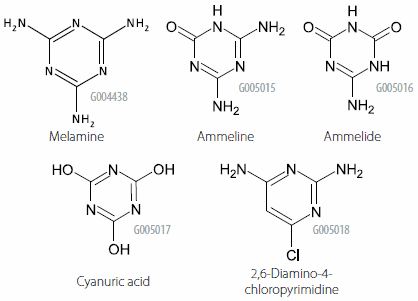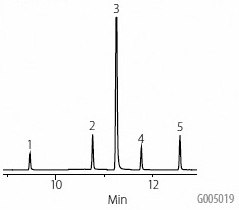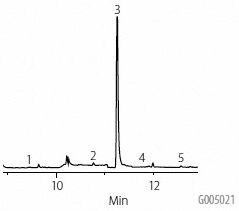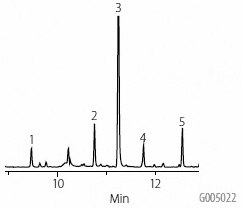Melamine Analysis via GC-MS
Katherine Stenerson, Michael D. Buchanan
Reporter US Volume 28.3
Site Overview
Introduction
Melamine contamination in food became an issue in recent years after the discovery of it, and related compounds, in pet food and baby formula. It was discovered that melamine was intentionally added to inflate nitrogen content, often the sole measure of the amount of protein in these products. The tainted food led to numerous illnesses, several fatalities, and massive product recalls. Currently, imported raw materials, namely wheat gluten and rice protein used to make these foods, as well as the actual consumer-ready foods, may undergo testing to ensure the absence of these compounds. We have detailed preparation and analytical procedures for these adulterants, using HPLC-MSMS instrumentation in previous publications1,2. In this article, we focus on the analysis of melamine and related compounds with the use of more economical gas chromatography-mass spectrometry (GC-MS) instrumentation.
GC-MS Method
The United States Food and Drug Administration (US FDA) adopted a screening method in October 2008 for the GC-MS analysis of melamine and related compounds in a variety of matrices3. Per the method, 0.5 g of the sample is mixed thoroughly with 20 mL of an extraction solvent mixture (10:40:50 diethylamine:water:acetonitrile). Following sonication (30 minutes) and centrifugation (10 minutes), an aliquot is filtered and evaporated to dryness. Sylon™ BFT and pyridine are then added along with an internal standard. The extract is then incubated (70 °C for 45 minutes) so that trimethylsilyl (TMS) derivatives of each analyte are formed. The resulting derivatized extract is then analyzed by GC-MS. The method allows the operation of the MS in the scan mode (m/z from 50-450 amu) or the selected ion monitoring (SIM) mode. Table 1 shows the structures of the four analytes (melamine, ammeline, ammelide, and cyanuric acid) plus 2,6-diamino-4-chloropyrimidine, the internal standard (I.S.) specified by the method.

Table 1.Melamine and Related Compounds
Experimental
For this work, we chose a common dry dog food obtained from a local grocery store. The following samples were prepared:
- Three calibration standards, each containing all four analytes, were made at levels of 10 ng/mL, 50 ng/mL, and 100 ng/mL (I.S. added at 1000 ng/mL in each), derivatized, and then used to perform a three-point calibration of the instrument.
- A laboratory blank was extracted (I.S. added at 1000 ng/mL), derivatized, and then analyzed to show cleanliness.
- A 0.5 g dog food sample was extracted (I.S. added at 1000 ng/ mL), derivatized, and then analyzed to determine analyte levels.
- A second 0.5 g dog food sample (spiked with each analyte at 10 μg/g) was extracted (I.S. added at 1000 ng/mL), derivatized, and then analyzed to determine method sensitivity and accuracy.
All standards and extracts were analyzed with the MS operating in the scan mode, and again later with the MS operating in the SIM mode.
Results
The following results were observed:
- MS Mode: Sensitivity was noticeably better when the MS was operated in the SIM mode. All chromatograms shown are from SIM mode analyses.
- Instrument Calibration: The 100 ng/mL standard is shown in Figure 1. Note the symmetrical peak shape for each analyte and the I.S., achieved because the activity of amide functional groups was minimized when TMS derivatives were formed, and also due to the inert nature of the capillary GC column.
- Laboratory Blank (Figure 2): Trace levels of each of the four target analytes were detected in the laboratory blank only when the MS was operated in the SIM mode.
- Dog Food Sample (Figure 3): The detection of analytes was at a level consistent with that observed in the laboratory blank. We concluded that this dog food was not contaminated with any of the target analytes.
- Spiked Dog Food Sample (Figure 4): The percent recoveries of each the four target analytes are summarized in Table 2. Good recovery was obtained for each analyte.
| column: | SLB™-5ms, 30m x 0.25 mm I.D., 0.25 μm (28471-U) |
| oven: | 115 °C (3 min.), 10 °C/min. to 325 °C (6 min.) |
| inj.: | 250 °C |
| MSD interface: | 325 °C |
| scan range: | SIM |
| carrier gas: | helium, 1 mL/min., constant |
| injection: | 1 μL, splitless |
| liner: | 4 mm I.D. single taper |
| sample: | 100 ng/mL standard containing each analyte at 100 ng/mL, then I.S. added at 1000 ng/mL, in pyridine:Sylon™ BFT to form TMS derivatives |
- Cyanuric acid
- Ammelide
- 2,6-Diamino-4-chloropyrimidine (I.S.)
- Ammeline
- Melamine

Figure 1.100 ng/mL Calibration Standard (SIM Mode) (referenced above is 28471-U)
sample: extract of a laboratory blank, then I.S. added at 1000 ng/mL, in pyridine: Sylon BFT to form TMS derivatives
Other conditions the same as Figure 1. See Figure 1 for Peak IDs.

Figure 2.Laboratory Blank (SIM Mode)
sample: extract of dog food, then I.S. added at 1000 ng/mL, in pyridine: Sylon BFT to form TMS derivatives
Other conditions the same as Figure 1. See Figure 1 for Peak IDs.

Figure 3.Dog Food Sample (SIM Mode)
sample: dog food spiked with each analyte at 10 µg/g, then extracted, then I.S. added at 1000 ng/mL, in pyridine: Sylon BFT to form TMS derivatives
Other conditions the same as Figure 1. See Figure 1 for Peak IDs.

Figure 4.Spiked Dog Food Sample (SIM Mode)
Conclusions
Our observation is that the method is very easy to perform and provides good sensitivity. In particular, the use of the specified extraction solvent mixture was found to be very effective in solubilizing and extracting all target analytes. Additionally, the formation of TMS derivatives allows these analytes to be analyzed by GC, with symmetrical peak shapes, high signal-to-noise ratios, and low detection levels.
Related Products
References
Trademark Attributes
- Sylon is a trademark of Sigma-Aldrich Co. LLC
- SLB is a trademark of Sigma-Aldrich Co. LLC
如要继续阅读,请登录或创建帐户。
暂无帐户?